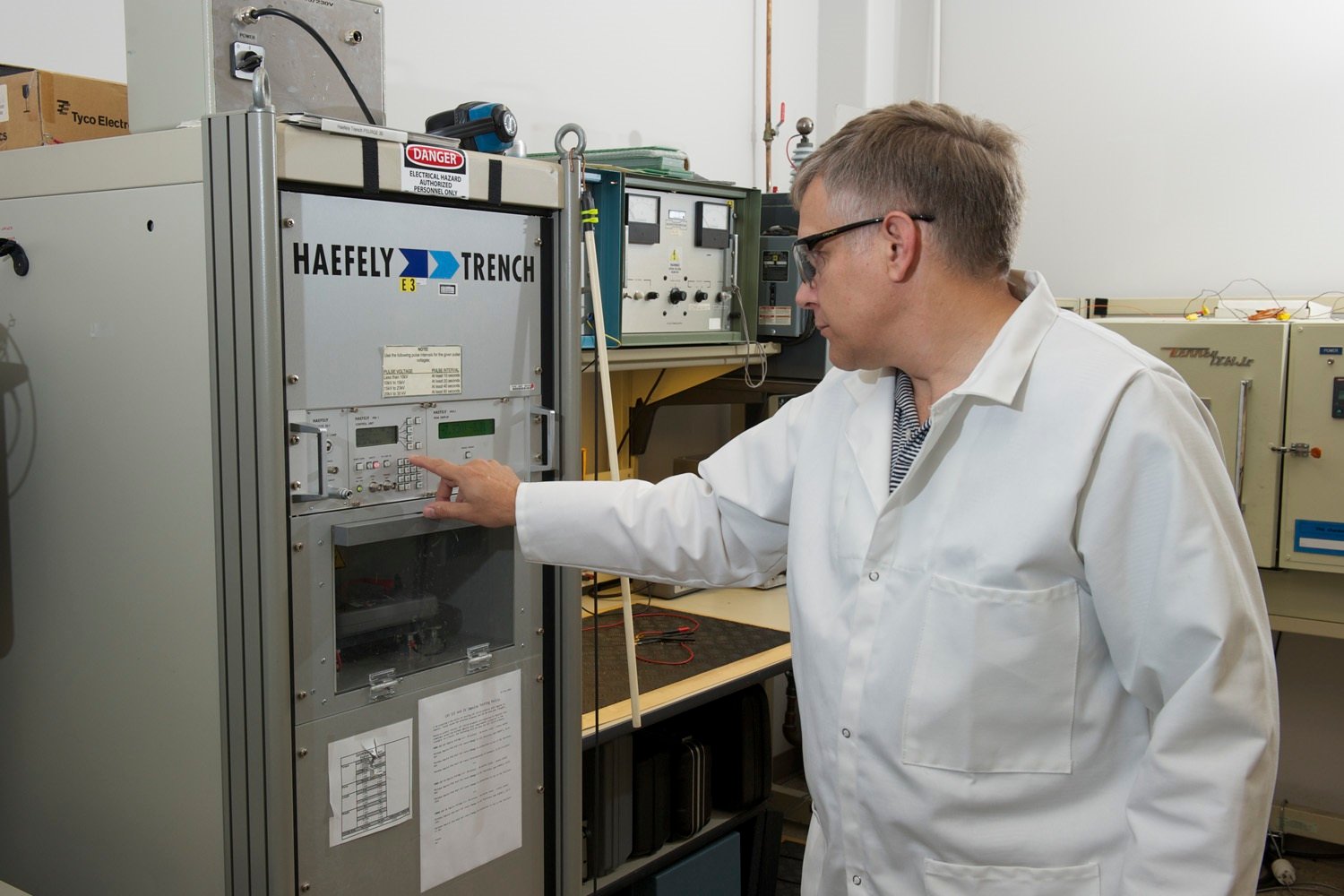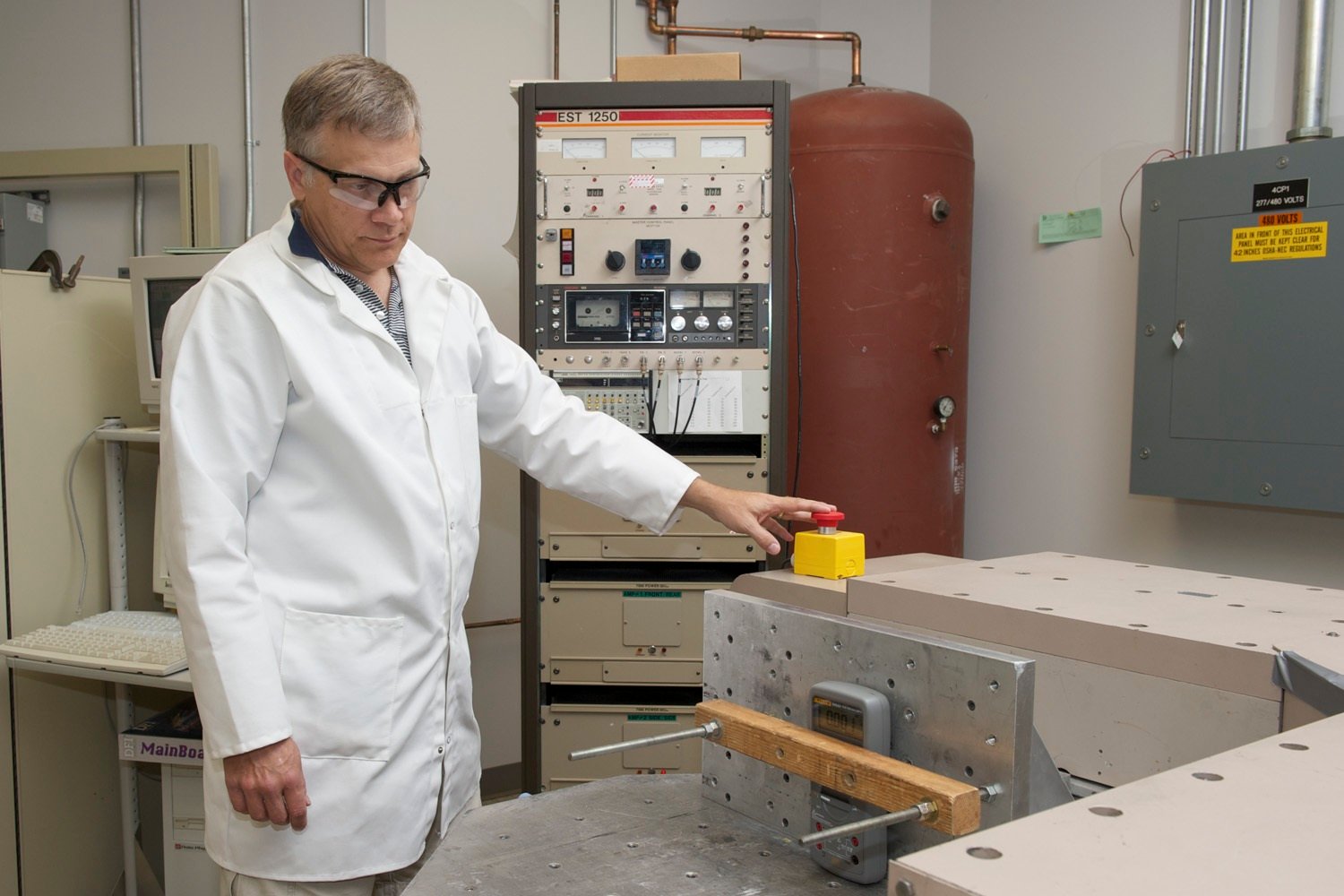Electricity is a fierce power. Dangerous if not respected. Deadly if unleashed by improper tools.
A well-built multimeter will protect against electrocution and arc explosion. It will carry a Measurement Category III rating as well as third party certification by an independent test lab. If the meter isn’t properly rated and certified, there is no way to tell if the meter offers necessary protection against electrical transients that may lead to insulation breakdown or arc explosion.
That is why Fluke takes product testing seriously. Its Product Compliance Laboratory pushes Fluke’s test and measurement tools beyond the defined standards to not only meet but exceed safety requirements. “We put the tools through a variety of foreseeable use and misuse scenarios replicating the conditions we’ve learned from our customers,” says Thomas Smith, Product Compliance Manager. “Once we know the tools demonstrate sufficient safety margin and robustness here, we can be confident in knowing they’ll provide a high level of protection in the real world.”
Indeed, before a Fluke product is certified by a third party, it is put through a series of performance and safety tests at Fluke. It’s baked and frozen, dunked in water, choked by dust clouds, rattled with vibration, bashed on the floor and zapped with electricity again and again.
 Product Compliance Laboratory Team, from left to right, Becky Faulk, Michael Meisner, James Lenker, Thomas Smith, John Morton, Chris Settle, Gary Allen, and Shahram Pourmoghadam.
Product Compliance Laboratory Team, from left to right, Becky Faulk, Michael Meisner, James Lenker, Thomas Smith, John Morton, Chris Settle, Gary Allen, and Shahram Pourmoghadam.Testing for safety and reliability
The Fluke Product Compliance Laboratory is filled with work stations jutting out from the walls and down the center of the large, well-lit room. Safety engineers—experts in testing protocols as well as various safety standards—push Fluke’s tools and instruments to breaking point. “We test at least one level beyond the standard. Additionally, our work in foreseeable misuse has led to the development of new standard requirements,” says Smith.
Fluke utilizes a variety of tests to find design weaknesses or errors that can then be fixed in the final instrument, thereby providing as much protection as possible from the inherent dangers of working with electrical systems.
Fluke works with all the major nationally recognized test labs (NRTLs) including: CSA (Canadian Standards Association), UL (Underwriters Laboratories), TÜV (Technischer Überwachungs-Verein), and ETL/Intertek. The Fluke Product Compliance laboratory is accredited through CSA to test and certify products for their certification mark. Test procedures are laid out in detail and adhered to rigorously. Once a product has passed the appropriate tests, documentation is sent on for approval and registration.
The Fluke lab is regularly audited to ensure that testing meets the requirements imposed by the national and international authorities and standards. Each test is precisely set up and calibrated to meet the requirements of the relevant standard.
Below are examples of Fluke testing approaches. Any robust and high-quality test instrument should undergo similar testing.
Impulse test
The impulse test simulates a transient on an electrical installation from nearby lightning strike or other large electrical disturbance from switch gear. A meter is placed in a chamber and injected with a pulse of thousands of volts of electricity, to verify whether the meter protection will rupture, breakdown, or arc over. A special test machine is used to generate the high voltage transient and fault current as defined by national and international standards.

Michael Meisner prepares a Fluke meter for the impulse test.
Multi-functional overload test
A test instrument should also be able to withstand accidental overloads associated with the various functions of the meter. This principal is so important that it has been written into current safety standards. Fluke simulates this by utilizing the multi-functional overload test. This test involves injecting very high-energy voltage into non-voltage measurement functions, testing for a case in which an operator mistakenly sends voltage into a non-voltage meter function. This might occur if the user leaves the leads in the amps input jacks and then accidentally connects the leads across a voltage source: they have just created a short through the test instrument.
Highly accelerated lifetime test (HALT)
To ensure the long life of its tools, Fluke uses HALT highly accelerated lifetime testing. The test combines high frequency 6-axis vibration at more than 150 GRMS (root-mean-square acceleration) with extremely fast temperature swings to simulate a lifetime of wear and tear. The chamber has the capability of going from -100 °C (-148 °F) to 200 °C (392 °F) in minutes, testing the tool’s ability to withstand elevated and combined stresses.
Transport under rugged conditions
Another test simulates meters being transported under rugged conditions, such as in off-road vehicles used by the military. Engineers place the meter on a vibration table where it is shaken at over 3 GRMS for at least 30 minutes per axis. Once is not enough. At Fluke, meters are repeatedly tested in several positions to account for all conceivable circumstances.

A meter is strapped into place for vibration testing.
Other tests
- Electrical static discharge (ESD)—withstand static electricity
- Ingress protection (IP) dust and water tests—resistance to dust intrusion and water (dripping, spraying, and submersion depending on rating), respectively
- Drop test—withstand “oops” factor even at the lowest temperature rating of the product
- Anechoic chamber lab test—withstand radiated electromagnetic interference without displaying erroneous readings, and do not emit disruptive radiation
- Temperature/humidity/altitude chambers—resistance to atmospheric extremes
Bringing safety home
An industrial outage could idle hundreds of employees, halt equipment worth millions, and bring production and revenue to a dead stop. It is essential that maintenance teams have tools they can rely on—tools tough enough to survive the dust, water, falls, and impacts common in industrial settings. Professionals demand the same level of accuracy, performance and get-it-done reliability from their tools as they expect from themselves. This is exactly what Fluke test and measurement tools are designed and built to do.
Safety standards to live by
The Switzerland-based International Electrotechnical Commission (IEC) 61010 establishes Measurement Category (CAT) and voltage ratings for electrical environments. These CAT ratings are based on how high-energy transient travels through the network resistance of the electrical installation. The ratings help determine what electrical test tools have been designed to withstand voltage transients for the specific job type.
- CAT II – Single-phase receptacle-connected loads such as appliances and portable tools
- CAT III – 3-phase distribution including single-phase commercial lighting and equipment in fixed locations such as switchgear and polyphase motors
- CAT IV – 3-phase at the utility connection, outdoor conductors, electricity meters, and service entrances
For example, a higher CAT number refers to an electrical environment with higher power available and higher energy transients. Thus, a multimeter designed to a CAT III standard is resistant to higher energy transients than one designed to CAT II standards.
Forensic investigations have determined that inferior test equipment—without a Measurement Category rating or with a rating that does not match the task—can sometimes explode if used improperly. Therefore, it is critical to make sure your electrical testing tools have been independently evaluated to survive voltage transients and certified to meet safety standards. Standardization bodies, such as the IEC and NFPA, are not responsible for enforcing their test tool safety standards—any test instrument you use should be labeled to indicate it has been certified by at least one independent testing agency.
Even the most careful of us will make mistakes. That’s why your test instruments should back you up with a margin of protection if an inappropriate voltage is applied. To meet the demands of today’s high-energy, high-hazard workplace, quality manufacturers like Fluke continue to improve their test instruments to make them safer and more reliable. Fluke goes a step further in designing and building our test tools for your safety. With stout input protection, our test instruments are built to survive.
Here are five common mistakes made in the field:
- Using outdated or defective test equipment
- Neglecting to properly inspect test instruments and test leads for damage or contamination
- Using the improperly rated test tools for the job
- Replacing original fuses with inadequate ones
- Working on live voltage without proper preparation
PRODUCT NOTE: Today’s digital multimeters include a special high-energy fuse designed to contain the fault current available from a CAT IV electrical installation. Replacing the fuse with an inadequate one increases your risk of exposure to arc explosion if a high energy voltage is applied in error to the current measurement terminals.